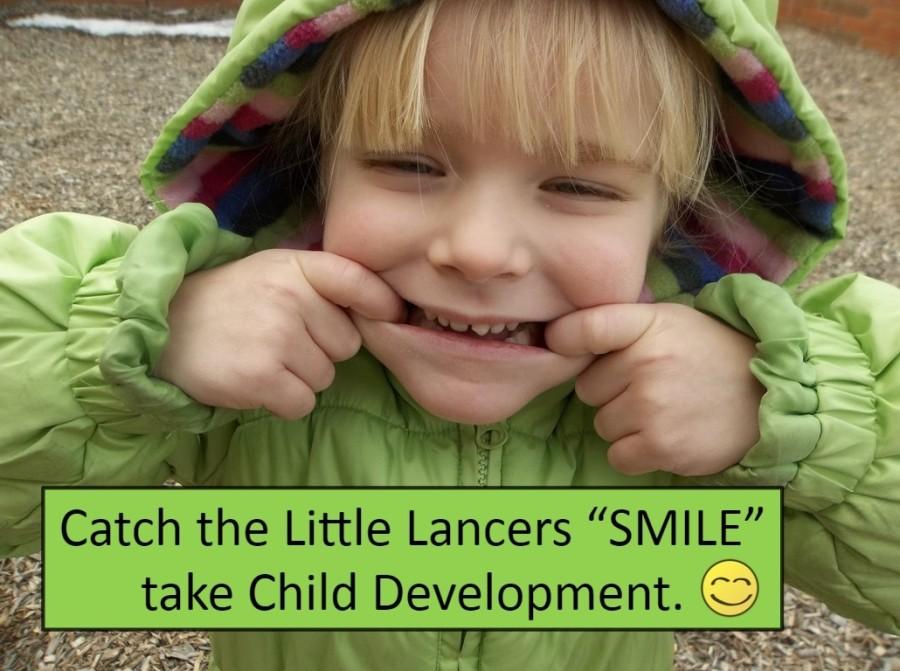Not everything is AP: Child Development courses create stronger future parents, citizens and families
A Little Lancer hams for the camera during playground time. This image is part of the promotional materials for the course.
March 16, 2016
By the time second period begins, most students are already counting down the minutes until the bell rings, but that’s not the case for Child Development students. While others are sitting in their seats struggling to stay awake, Mrs. Kate Lane’s students are welcoming the Little Lancers into the school and preparing for their lessons.
Every FCPS high school offers a Child Development course, but it’s not an AP course, so should teenagers still take it? The answer is yes! Child Development offers more than what some may see on the surface.
The Child Development course at Linganore offers Lancers the ability to teach young children ages 3 to 6 in the Little Lancers Preschool, a unique experience for students of high school age. This is not “old school babysitting.”
“From the outside it may appear that preschool teachers may just play all day long, but I am sure once you help a child construct their first building, help them write their name, or draw a picture it will be recognized that all of that playing translated into a growth experience for a young child,” said Joanne Garabedian, a preschool teacher at Deer Crossing Elementary School.
One of the more obvious reasons to take a Child Development course is it allows the student-teacher to gain the basic education they need in order to become a preschool teacher. By completing three Child Development courses while maintaining at least a B average, students can obtain a 90-hour certificate from Frederick Community College (FCC) which employees need in order to become preschool teachers.
Instead of paying hundreds of dollars out of pocket to earn this certificate in college, why not take these courses and get them for free in high school?
“Child Development has helped me gain skills in working with children, how to assist them in growing, and has helped solidify my decision to work with children in my future career,” said junior Erin Lafferty, a Child Development 3 student.
If you are not planning to pursue a career in early childhood education, Childhood Development may still be for you. There are a lot of life-long skills to learn from the class.
“Sometimes when we hear someone say preschool, they think it’s two hours a day, finger painting, and awesome-and it is, but there is a lot of depth to this work. You need to know why you want to do this. It has to go beyond liking children. You need to be patient, and you need to understand child development,” said Lisa Murphy, more popularly known as the Ooey Gooey Lady.
Murphy is an educator of early childhood development. She conducts between 100 and 180 seminars a year across the country, traveling approximately 300 days of the year. She started conducting seminars in 1997 in hopes of inspiring other teachers to teach in a creative and developmentally appropriate way. She has published and sold many books and movies throughout her career, attracting the attention of many inspired early childhood development teachers.
The assignments allow students to use and develop skills important to life after school. These skills include social skills, creativity, parenting skills, leadership, and a good work ethic.
Student teachers are expected to communicate not only with the children and peers, but also the children’s parents. Each semester, the assignments become more realistic to a preschool teacher’s daily routine.
“You need to be able to work with their families. You need to build relationships with the mom, the dad, the stepmom, the stepdad, the grandmother the granddad,” said Murphy.
In Child Development 1, new students are be expected to create lesson plans that correspond with the weekly theme. Students also learn the stages of physical development children go through as they age.
Child Development 2 and 3 students are expected to create lesson plans implementing their knowledge of a child’s psychological growth.
Teenagers who are already parents (or plan to become parents) can also benefit from this course. The information helps student-teachers to understand the way children think and develop, giving future or current parents the knowledge they need in order to give their child the necessities for a successful development.
Thirty percent of female dropouts say that they drop out because of an unplanned pregnancy. On average, high school graduates earn $1 million more than people who dropped out. Only half of the mothers who dropped out due to teenage pregnancy earned their high school diploma by the age of 22.
In 2011, according to the U.S. Department of Health & Human Services, there were over 4,000 teen births in the state of Maryland alone. By educating students on the necessities and difficulties of raising a child, teenagers are statistically less likely to become pregnant.
“Child Development has helped me learn how to work better with children and know in the future how to help my own child develop at a good rate,” says senior Kaycee Oland, a Child Development 2 student.
According to researchers at Stanford University, by three years of age, children from poor families have a 30 million word gap between children from wealthy families. Preschool teachers are able to help these children by supplying an early intervention. They can help reinforce children’s vocabulary by building onto what they already know, closing the gap.
In 2013, according to the Child Welfare League of America, 12,397 children were abused in the state of Maryland. The content of the Child Development class helps students be aware of the long-term effect of abuse.
By educating young people about the emotional and physical harm abuse has on a child, it will be easier to change their attitude and expectations towards children.
I have been enrolled in Child Development for three years now. When I graduate high school, I will be able to look back and remember all of the fun experiences I have had with my teacher, my friends, and most of all, the children.
“In my inclusive pre-k class there are students with special needs, and it is great watching everyone playing, working together, and accepting each other. Young children seem to accept and love each other naturally, and it is a beautiful thing,” says Garabedian.
These children can grow up to do something great! You may be helping a star athlete, a celebrity, a Nobel Peace Prize winner. Being able to say that you helped shape a person is a privilege that is offered right here at Linganore. Take a moment to consider Child Development.






